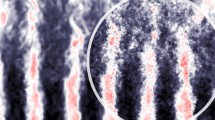Abstract
In this paper, we investigate the performance of particle tracking, exploring the influence of an increasing amount of estimators. Basically, a simple method to determine particle matchings was used. Then, first, temporal extrapolation as well as spatial interpolation are employed. Second, a PIV processing step was incorporated. Tests from simulations show that at relatively high seeding densities the performance was increased by a factor of 4 and 13 for the first and second step, respectively. In a physical experiment of a wake behind a heated cylinder, a clear performance improvement in the case of PIV preprocessing was observed.
Similar content being viewed by others
Author information
Authors and Affiliations
Additional information
Received: 4 April 2001 / Accepted: 9 August 2001
Rights and permissions
About this article
Cite this article
Bastiaans, R., van der Plas, G. & Kieft, R. The performance of a new PTV algorithm applied in super-resolution PIV. Experiments in Fluids 32, 346–356 (2002). https://doi.org/10.1007/s003480100363
Issue Date:
DOI: https://doi.org/10.1007/s003480100363




